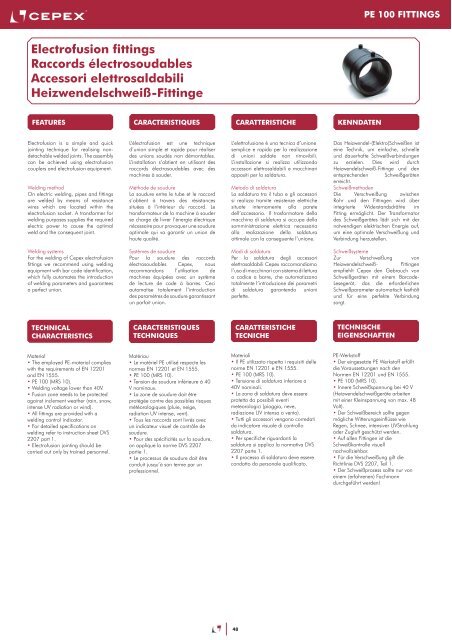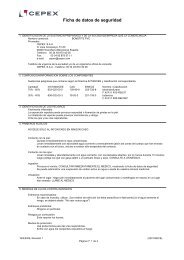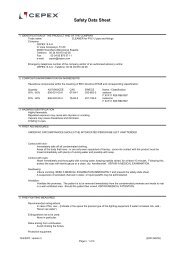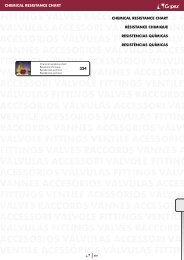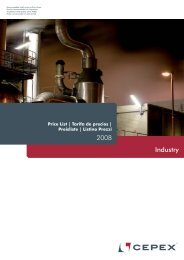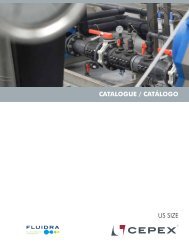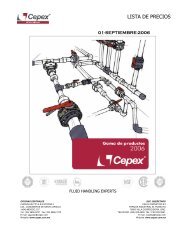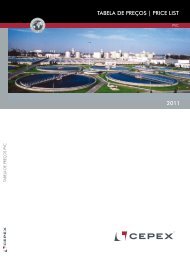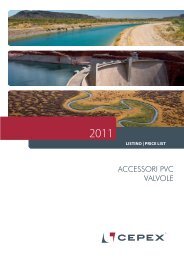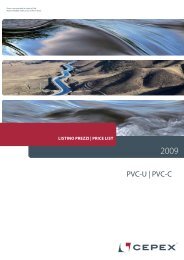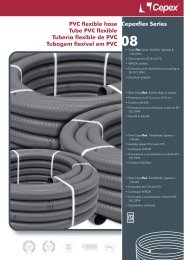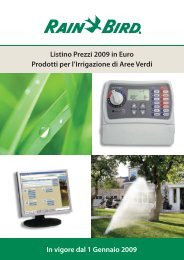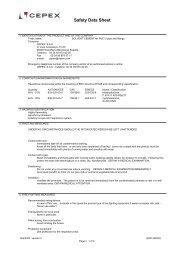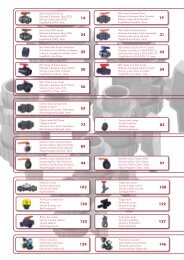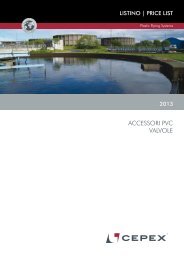PP | PE - Cepex
PP | PE - Cepex
PP | PE - Cepex
You also want an ePaper? Increase the reach of your titles
YUMPU automatically turns print PDFs into web optimized ePapers that Google loves.
Electrofusion fittings<br />
Raccords électrosoudables<br />
Accessori elettrosaldabili<br />
Heizwendelschweiß-Fittinge<br />
FEATURES CARACTERISTIQUES CARATTERISTICHE KENNDATEN<br />
Electrofusion is a simple and quick<br />
jointing technique for realising nondetachable<br />
welded joints. The assembly<br />
can be achieved using electrofusion<br />
couplers and electrofusion equipment.<br />
Welding method<br />
On electric welding, pipes and fittings<br />
are welded by means of resistance<br />
wires which are located within the<br />
electrofusion socket. A transformer for<br />
welding purposes supplies the required<br />
electric power to cause the optimal<br />
weld and the consequent joint.<br />
Welding systems<br />
For the welding of <strong>Cepex</strong> electrofusion<br />
fittings we recommend using welding<br />
equipment with bar code identification,<br />
which fully automates the introduction<br />
of welding parameters and guarantees<br />
a perfect union.<br />
TECHNICAL<br />
CHARACTERISTICS<br />
Material<br />
• The employed <strong>PE</strong>-material complies<br />
with the requirements of EN 12201<br />
and EN 1555.<br />
• <strong>PE</strong> 100 (MRS 10).<br />
• Welding voltage lower than 40V.<br />
• Fusion zone needs to be protected<br />
against inclement weather (rain, snow,<br />
intense UV radiation or wind).<br />
• All fittings are provided with a<br />
welding control indicator.<br />
• For detailed specifications on<br />
welding refer to instruction sheet DVS<br />
2207 part 1.<br />
• Electrofusion jointing should be<br />
carried out only by trained personnel.<br />
L’électrofusion est une technique<br />
d’union simple et rapide pour réaliser<br />
des unions soudés non démontables.<br />
L’installation s’obtient en utilisant des<br />
raccords électrosoudables avec des<br />
machines à souder.<br />
Méthode de soudure<br />
La soudure entre le tube et le raccord<br />
s’obtient à travers des résistances<br />
situées à l’intérieur du raccord. Le<br />
transformateur de la machine à souder<br />
se charge de livrer l’énergie électrique<br />
nécessaire pour provoquer une soudure<br />
optimale qui va garantir un union de<br />
haute qualité.<br />
Systèmes de soudure<br />
Pour la soudure des raccords<br />
électrosoudables <strong>Cepex</strong>, nous<br />
recommandons l’utilisation de<br />
machines équipées avec un système<br />
de lecture de code à barres. Ceci<br />
automatise totalement l’introduction<br />
des paramètres de soudure garantissant<br />
un parfait union.<br />
CARACTERISTIQUES<br />
TECHNIQUES<br />
Matériau<br />
• Le matériel <strong>PE</strong> utilisé respecte les<br />
normes EN 12201 et EN 1555.<br />
• <strong>PE</strong> 100 (MRS 10).<br />
• Tension de soudure infèrieure à 40<br />
V nominaux.<br />
• La zone de soudure doit être<br />
protégée contre des possibles risques<br />
météorologiques (pluie, neige,<br />
radiation UV intense, vent).<br />
• Tous les raccords sont livrés avec<br />
un indicateur visuel de contrôle de<br />
soudure.<br />
• Pour des spécificités sur la soudure,<br />
on applique la norme DVS 2207<br />
partie 1.<br />
• Le processus de soudure doit être<br />
conduit jusqu’à son terme par un<br />
professionnel.<br />
L’elettrofusione è una tecnica d’unione<br />
semplice e rapida per la realizzazione<br />
di unioni saldate non rimovibili.<br />
L’installazione si realizza utilizzando<br />
accessori elettrosaldabili e macchinari<br />
appositi per la saldatura.<br />
Metodo di saldatura<br />
La saldatura tra il tubo e gli accessori<br />
si realizza tramite resistenze elettriche<br />
situate internamente alla parete<br />
dell’accessorio. Il trasformatore della<br />
macchina di saldatura si occupa della<br />
somministrazione elettrica necessaria<br />
alla realizzazione della saldatura<br />
ottimale con la conseguente l’unione.<br />
Modi di saldatura<br />
Per la saldatura degli accessori<br />
elettrosaldabili <strong>Cepex</strong> raccomandiamo<br />
l’uso di macchinari con sistema di lettura<br />
a codice a barre, che automatizzano<br />
totalmente l’introduzione dei parametri<br />
di saldatura garantendo unioni<br />
perfette.<br />
CARATTERISTICHE<br />
TECNICHE<br />
Materiali<br />
• Il <strong>PE</strong> utilizzato rispetta i requisiti delle<br />
norme EN 12201 e EN 1555.<br />
• <strong>PE</strong> 100 (MRS 10).<br />
• Tensione di saldatura inferiore a<br />
40V nominali.<br />
• La zona di saldatura deve essere<br />
protetta da possibili eventi<br />
meteorologici (pioggia, neve,<br />
radiazione UV intensa o vento).<br />
• Tutti gli accessori vengono corredati<br />
da indicatore visuale di controllo<br />
saldatura.<br />
• Per specifiche riguardanti la<br />
saldatura si applica la normativa DVS<br />
2207 parte 1.<br />
• Il processo di saldatura deve essere<br />
condotto da personale qualificato.<br />
48<br />
<strong>PE</strong> 100 FITTINGS<br />
Das Heizwendel-(Elektro)Schweißen ist<br />
eine Technik, um einfache, schnelle<br />
und dauerhafte Schweißverbindungen<br />
zu erzielen. Dies wird durch<br />
Heizwendelschweiß-Fittinge und den<br />
entsprechenden Schweißgeräten<br />
erreicht.<br />
Schweißmethoden<br />
Die Verschweißung zwischen<br />
Rohr und den Fittingen wird über<br />
integrierte Widerstandsdrähte im<br />
Fitting ermöglicht. Der Transformator<br />
des Schweißgerätes lädt sich mit der<br />
notwendigen elektrischen Energie auf,<br />
um eine optimale Verschweißung und<br />
Verbindung herzustellen.<br />
Schweißsysteme<br />
Zur Verschweißung von<br />
Heizwendelschweiß- Fittingen<br />
empfiehlt <strong>Cepex</strong> den Gebrauch von<br />
Schweißgeräten mit einem Barcode-<br />
Lesegerät, das die erforderlichen<br />
Schweißparameter automatisch festhält<br />
und für eine perfekte Verbindung<br />
sorgt.<br />
TECHNISCHE<br />
EIGENSCHAFTEN<br />
<strong>PE</strong>-Werkstoff<br />
• Der eingesetzte <strong>PE</strong> Werkstoff erfüllt<br />
die Voraussetzungen nach den<br />
Normen EN 12201 und EN 1555.<br />
• <strong>PE</strong> 100 (MRS 10).<br />
• Innere Schweißspannung bei 40 V<br />
(Heizwendelschweißgeräte arbeiten<br />
mit einer Kleinspannung von max. 48<br />
Volt).<br />
• Der Schweißbereich sollte gegen<br />
mögliche Witterungseinflüsse wie<br />
Regen, Schnee, intensiver UVStrahlung<br />
oder Zugluft geschützt werden.<br />
• Auf allen Fittingen ist die<br />
Schweißkontrolle visuell<br />
nachvollziehbar.<br />
• Für die Verschweißung gilt die<br />
Richtlinie DVS 2207, Teil 1.<br />
• Der Schweißprozess sollte nur von<br />
einem (erfahrenen) Fachmann<br />
durchgeführt werden!


